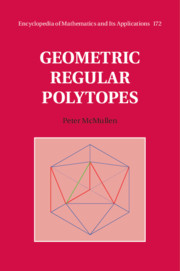Book contents
- Frontmatter
- Contents
- Foreword
- I Regular Polytopes
- 1 Euclidean Space
- 2 Abstract Regular Polytopes
- 3 Realizations of Symmetric Sets
- 4 Realizations of Polytopes
- 5 Operations and Constructions
- 6 Rigidity
- II Polytopes of Full Rank
- III Polytopes of Nearly Full Rank
- IV Miscellaneous Polytopes
- Afterword
- Bibliography
- Notation Index
- Author Index
- Subject Index
5 - Operations and Constructions
from I - Regular Polytopes
Published online by Cambridge University Press: 30 January 2020
- Frontmatter
- Contents
- Foreword
- I Regular Polytopes
- 1 Euclidean Space
- 2 Abstract Regular Polytopes
- 3 Realizations of Symmetric Sets
- 4 Realizations of Polytopes
- 5 Operations and Constructions
- 6 Rigidity
- II Polytopes of Full Rank
- III Polytopes of Nearly Full Rank
- IV Miscellaneous Polytopes
- Afterword
- Bibliography
- Notation Index
- Author Index
- Subject Index
Summary
Various operations and constructions on groups, both abstract and geometric, are described, which lead, at least putatively, from old regular polytopes to new ones. Two basic kinds of operations, mixing and twisting, are of fundamental importance. However, there is a certain amount of overlap, and some string C-groups can be derived from other groups by both methods. There is a wide range of mixing operations, which work on an abstract as well as geometric level; they are first treated abstractly. One important case for the future is Petrie contraction, but other operations such as faceting, halving, skewing and so on will occur frequently. Conversely, some twisting operations will not work geometrically, or will only work in restricted circumstances. There are also purely geometric operations, such as replacing one or more generating reflexions of a symmetry group by their products with commuting (geometric) involutions; centriversion and eversion are important special cases. There are general extensions, particularly the abelian extension. Finally, the general notion of constructing regular polytopes in a recursive way suggested by the initial definition of a polytope is investigated; a special case is the abelian extension. This idea concentrates on restrictions on vertex-figures as basic building blocks for regular polytopes of one higher rank when the corank is small.
- Type
- Chapter
- Information
- Geometric Regular Polytopes , pp. 169 - 199Publisher: Cambridge University PressPrint publication year: 2020

